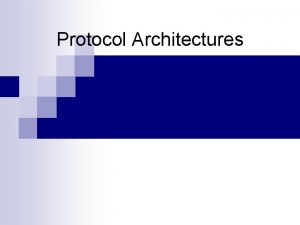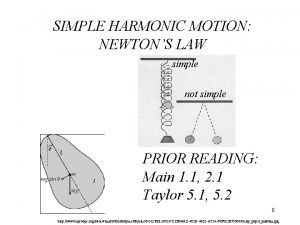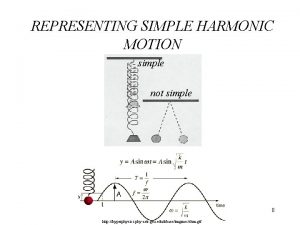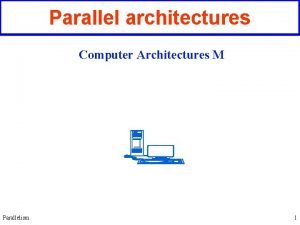Protocol Architectures Simple Protocol Architecture Not an actual












- Slides: 12

Protocol Architectures

Simple Protocol Architecture • Not an actual architecture, but a model for how they work • Similar to “pseudocode, ” used for teaching programming • Once we understand the building blocks, we can look at specific examples – Open Systems Interconnection (OSI) 7 -Layer Model – TCP/IP

Why Use Protocol Architecture? • Data communications requires complex procedures – Sender identifies data path/receiver – Systems negotiate preparedness – Applications negotiate preparedness – Translation of file formats • For all tasks to occur, high level of cooperation is required

Modular Approach • Break tasks into subtasks • Each module handles specific subset of tasks • Communication occurs – between different modules on the same system – between similar modules on different systems

Simple Modular Example • File transfer facility • Three modules – File transfer module could handle translation and inter-application communication – Communication service module could handle negotiation of preparedness, data flow – Network access module could handle data path

Advantages of Modularity • Easier application development • Network can change without all programs being modified

Three-Layer Model • Distributed data communications involves three primary components: – Applications – Computers – Networks • Three corresponding layers – Network access layer – Transport layer – Application layer

Network Access Layer • Concerned with exchange of data between computer and network • Includes addressing, routing, prioritizing, etc • Different networks require different software at this layer

Transport Layer • Concerned with reliable transfer of information between applications • Independent of the nature of the application • Includes aspects like flow control and error checking

Application Layer • Logic needed to support various applications • Each type of application (file transfer, remote access) requires different software on this layer

Addressing • Each computer on a network requires a unique address on that network • Each application on the computer must have a unique address within the computer to allow the transport layer to support multiple applications • Data units must include network and application addresses

Standardized Protocol Architectures • Vendors like standards because they make their products more marketable • Customers like standards because they enable products from different vendors to interoperate • Two protocol standards are well-known: – TCP/IP: widely implemented – OSI: well-known, less used, still useful for modeling/conceptualizing
 Actual-theoretical/actual
Actual-theoretical/actual How does sanctifying grace differs from actual grace
How does sanctifying grace differs from actual grace Integral product architecture
Integral product architecture Database and storage architectures
Database and storage architectures Ansi sparc
Ansi sparc Switched backbone networks
Switched backbone networks Autoencoders, unsupervised learning, and deep architectures
Autoencoders, unsupervised learning, and deep architectures George schlossnagle
George schlossnagle Modular product architectures
Modular product architectures Gui architectures
Gui architectures Database system architectures
Database system architectures Cdn architectures
Cdn architectures Scalable web architectures
Scalable web architectures























